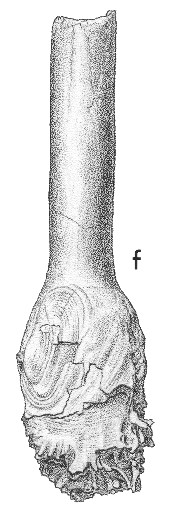
Revised descriptions of New Zealand Cenozoic Mollusca from Beu and Maxwell (1990)

 | Revised descriptions of New Zealand Cenozoic Mollusca from Beu and Maxwell (1990) | 
|
  (Pl. 19f): holotype, GS9572, J41/f8040, Gee Greensand, c. 12 m below shellbed, Target Gully, Oamaru, Altonian (TM5458, GNS) |
Beu & Maxwell (1990): Chapter 11; p. 187; pl. 19 f.
Synonymy: Clavagella oamarutica Maxwell 1978, p. 28
Classification: Clavagellidae
Description: Size moderate for family (length probably up to 100 mm), anterior end of tube (sac) inflated, more so dorsoventrally than laterally, bearing numerous irregularly branching tubules and frill-like processes on anterior end and (on some shells) on part of right side. Rest of tube narrower, rather irregular, ovate in section, smooth, posterior end probably simple. Left valve subrectangular, attached to sac and visible on exterior, early portion with sculpture of radial rows of minute papillae, remainder with growth lines and numerous, fine, oblique wrinkles. Right valve free in interior, sculpture like that of left valve; hinge edentulous; pallial sinus moderately deep, narrowly triangular.
Comparison: Clavagellids are among the most bizarre of all known bivalves, having one or both valves attached to the anterior end of a rigid tubular structure in the adult. Some species are adapted for burrowing in soft sediments, others for nestling in cracks or inside shells. The holotype of Clavagella oamarutica possibly lived in a subhorizontal position on or near the surface of the sediment, but other specimens seem to have nestled in the umbonal cavity of bivalves. Brian Morton in several publications has revolutionised the classification and knowledge of the functional morphology of the "watering pot shells". In his overview paper (Morton 2007) he separated off a family Penicillidae for Penicillus, Brechites, Foegia, Nipponoclava, Kendrickiana, and Humphreyia, etc., from the Clavagelidae containing Clavagella, Dacosta, Bryopa, Dianadema, Stirpulina, and such bizarre fossils as Ascaulocardium. The tube or "crypt" in which these taxa live in the sediment, or attached to shells, etc., is formed in quite different ways in the two families, and Morton (2007) suggested that they evolved from distinct lyonsiid ancestors. Morton is in the process of recording a species of Stirpulina and a second Clavagella species from New Zealand Miocene rocks.
Distribution: Altonian; Gee Greensand, Target Gully (type) (not uncommon); Awamoa Beach (rare); possibly also represented by specimens of Altonian to Waiauan age from Mokau, Taranaki, Ngahape, Wairarapa and Clifden, Southland. Specimens from the Chatton Formation, Shell Gully, Chatton (Duntroonian) possibly represents another species, and other clavagellids are now known from several localities in New Zealand.
Cite this publication as: "A.G. Beu and J.I. Raine (2009). Revised
descriptions of New Zealand Cenozoic Mollusca from Beu and Maxwell (1990). GNS
Science miscellaneous series no. 27."
© GNS Science, 2009
ISBN
978-0-478-19705-1
ISSN 1177-2441
(Included with a PDF facsimile file
copy of New Zealand Geological Survey Paleontological Bulletin 58 in CD version
from: Publications Officer, GNS Science, P.O. Box 30368 Lower Hutt, New
Zealand)